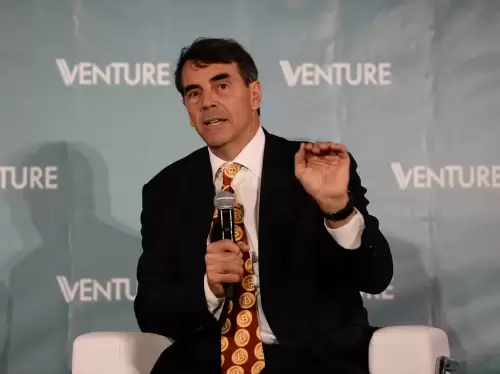 |
|
 |
|
 |
|
 |
|
 |
|
 |
|
 |
|
 |
|
 |
|
 |
|
 |
|
 |
|
 |
|
 |
|
 |
|
分散型デリバティブプラットフォームSynthetixの共同設立者であるKain Warwickは、彼が欺ceptive戦術として説明するものに光を当てました

Kain Warwick, the co-founder of decentralized derivatives platform Synthetix, has shed light on what he describes as the deceptive tactics employed by market makers (MMs) to manipulate cryptocurrency prices.
分散型デリバティブプラットフォームSynthetixの共同設立者であるKain Warwickは、暗号通貨の価格を操作するためにマーケットメーカー(MMS)が採用している欺cept的な戦術として説明しているものに光を当てています。
In a detailed post on X, Warwick recounted the evolution of these entities, from their initial role in facilitating exchange listings to orchestrating intricate price schemes that often leave retail investors holding devalued assets as exit liquidity.
Xの詳細な投稿で、ワーウィックは、これらのエンティティの進化を、交換リストの促進における最初の役割から、小売投資家が減少した資産を出てくる流動性としてしばしば残す複雑な価格スキームを調整するまで、これらのエンティティの進化を語りました。
During the initial coin offering (ICO) boom, Warwick noted that projects were typically required to pay market makers substantial fees, ranging from $50,000 to $300,000 per month, to secure listings on cryptocurrency exchanges and attract significant investors. He pointed out that without these often costly deals, it was nearly impossible for emerging projects to secure the necessary capital and exchange listings.
ワーウィックは、最初のコイン提供(ICO)ブームの中で、月額50,000ドルから300,000ドルの範囲の市場メーカーに多額の料金を支払うためにプロジェクトが必要であり、暗号通貨取引所のリストを確保し、重要な投資家を引き付けると指摘しました。彼は、これらのしばしば費用のかかる取引がなければ、新たなプロジェクトが必要な資本と交換のリストを確保することはほぼ不可能であると指摘しました。
However, Warwick highlighted that as early as 2017, some market makers began to shift their focus towards more manipulative tactics.
しかし、ワーウィックは、2017年に早くも、一部のマーケットメーカーがより操作的な戦術に焦点を移し始めたことを強調しました。
Instead of prioritizing genuine liquidity provision, these MMs allegedly started artificially inflating trading volumes on smaller, lesser-known exchanges while strategically avoiding scrutiny on major platforms like Binance and Kraken.
本物の流動性の提供に優先順位を付ける代わりに、これらのMMSは、BinanceやKrakenなどの主要なプラットフォームで戦略的に精査を避けながら、小規模であまり知られていない交換の取引量を人為的に膨らませ始めたと言われています。
Warwick explained how market makers began using call option structures to profit from price manipulation.
ワーウィックは、マーケットメーカーがどのようにコールオプション構造を使用して価格操作から利益を得始めたかを説明しました。
Rather than providing genuine liquidity to the market, these MMs would allegedly engage in tactics to artificially pump up the prices of tokens. Once the price reached a certain level, they would exercise their call options and then quickly dump their holdings onto the market for profit.
これらのMMSは、本物の流動性を市場に提供するのではなく、トークンの価格を人為的に盛り上げるために戦術に従事していると言われています。価格が一定のレベルに達すると、彼らは彼らのコールオプションを行使し、その後、利益のために彼らの保有を市場にすばやく捨てます。
The low float strategy, which involves launching a token with a limited number of coins initially available for trading, and which gained popularity through figures like Sam Bankman-Fried, further amplified the value and effectiveness of these manipulative call option schemes.
低フロート戦略は、最初に取引に利用できる限られた数のコインでトークンを起動することを伴い、サムバンクマンフリードのような数字を通じて人気を獲得し、これらの操作的なコールオプションスキームの価値と有効性をさらに増幅しました。
With fewer tokens in circulation at the time of launch, market makers could exert more control over the price action.
打ち上げ時に流通しているトークンが少ないため、マーケットメーカーは価格アクションをより多くの制御を行うことができました。
They would allegedly sell into market bids to create artificial buying pressure, short the token to further drive down the price, and then buy back their positions at lower prices, ensuring maximum profits from these orchestrated price swings.
彼らは、人為的な購入圧力を作成するために市場入札に売却され、トークンを短くして価格をさらに引き下げ、より低い価格でポジションを買い戻し、これらの編成された価格変動からの最大の利益を確保すると言われています。
According to Warwick, projects now sell discounted tokens to liquidity funds before their Token Generation Event (TGE).
ワーウィックによると、プロジェクトは現在、トークン生成イベント(TGE)の前に、割引トークンを流動性ファンドに販売しています。
These funds then agree to bid strategically on the market, creating a false impression of strong demand for the token.
これらの資金は、市場に戦略的に入札することに同意し、トークンに対する強い需要の誤った印象を生み出します。
Simultaneously, a large portion of tokens is sent to exit-strategy MMs, who then proceed to dump these tokens into the artificially inflated market.
同時に、トークンの大部分がExit-StrategyMMSに送信されます。
This cycle enables MMs and early investors to exit with profits while leaving retail buyers holding devalued tokens. Warwick cautioned that large token transfers to market makers should be viewed as a red flag, potentially indicating such manipulative schemes are underway.
このサイクルにより、MMSと初期の投資家は、小売バイヤーが切り下げられたトークンを保持している間、利益を得ることができます。ワーウィックは、マーケットメーカーへの大規模なトークンの転送は、そのような操作スキームが進行中であることを示す可能性があることを示す可能性があることを示す可能性があると述べています。
Warwick expressed his disdain for these tactics, emphasizing that a legitimate market maker should focus on providing liquidity with tight bid-ask spreads rather than manipulating prices. He urged investors to demand greater transparency from projects engaging with MMs.
ワーウィックは、これらの戦術に対する軽daを表明し、合法的なマーケットメーカーは、価格を操作するのではなく、緊密な入札スプレッドで流動性を提供することに集中すべきだと強調しました。彼は投資家に、MMSに従事するプロジェクトからより大きな透明性を要求するよう促した。
He also revealed that Synthetix was among the first projects to be exploited by DWF Labs.
彼はまた、SynthetixがDWF Labsによって悪用された最初のプロジェクトの1つであることを明らかにしました。
Warwick stated that DWF Labs purportedly purchased treasury tokens from Synthetix, engaged in activities to pump the price in a low-liquidity environment, and then dumped their holdings for profit, leaving Synthetix and its community to deal with the consequences.
Warwickは、DWF LabsがSynthetixから財務省のトークンを購入し、低液性環境で価格を投入する活動に従事し、その後、Synthetixとそのコミュニティが結果に対処するために保有を捨てたと述べました。
免責事項:info@kdj.com
提供される情報は取引に関するアドバイスではありません。 kdj.com は、この記事で提供される情報に基づいて行われた投資に対して一切の責任を負いません。暗号通貨は変動性が高いため、十分な調査を行った上で慎重に投資することを強くお勧めします。
このウェブサイトで使用されているコンテンツが著作権を侵害していると思われる場合は、直ちに当社 (info@kdj.com) までご連絡ください。速やかに削除させていただきます。

























































![注目に値する50%の集会の後、Dogecoin [doge]は0.25ドルのキーレジスタンスレベルの近くで統合されているように見えます 注目に値する50%の集会の後、Dogecoin [doge]は0.25ドルのキーレジスタンスレベルの近くで統合されているように見えます](/uploads/2025/05/14/cryptocurrencies-news/articles/notable-rally-dogecoin-doge-appears-consolidating-key-resistance-level/image_500_300.webp)
